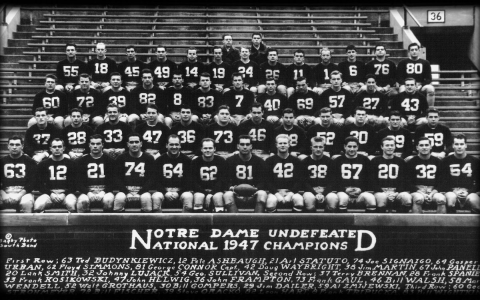The 2011 Notre Dame Fighting Irish football team entered the season with high hopes and expectations. Led by head coach Brian Kelly, the team aimed to return to prominence in college football. Despite facing challenges, several key players emerged throughout the season, influencing the results and ultimately shaping the team\’s narrative.
As the season progressed, one player consistently shined on the field: Dayne Crist. Initially the starting quarterback, Crist faced intense pressure, both from opposing defenses and internal competition. His performance in the early games was promising, including a solid outing against USF, where he threw for 300 yards. However, inconsistency plagued him, and after a few games, Kelly made the tough decision to replace him with Tommy Rees.
Tommy Rees took the field in relief and showcased a different approach. From that moment on, Rees quickly became a fan favorite. Notably, his ability to read defenses improved as the season unfolded. Against Miami, Rees threw for over 300 yards, leading the Irish to an impressive victory. Fans felt the spark he brought to the offense. His play evoked comments from teammates, who praised his poise and ability to rally the team during crunch time.
Meanwhile, Cierre Wood emerged as the key running back for the Fighting Irish this season. Wood displayed a unique blend of speed and power. Throughout the season, he recorded over 1,000 rushing yards, becoming the backbone of the offense. His performance against Boston College, where he rushed for 150 yards, exemplified his explosive style. Wood’s dedication to training and preparation paid off and he made his imprint on not just games, but also the locker room culture.
The receivers also played crucial roles in the team\’s success. Michael Floyd, in particular, stood out with his exemplary performances. Floyd was a possession receiver who could stretch the field; his 1,000+ yards receiving season highlighted his impact. He brought a veteran presence and was often the go-to target on crucial downs. His connection with Rees became evident during close games, allowing the Fighting Irish to pull through tough matchups.
Despite all these strengths, the 2011 season had its share of challenges. Injuries plagued the team, affecting key positions and forcing players into unfamiliar roles. Particularly, the offensive line struggled at times with depth, leading to inconsistencies in both protection and run blocking. Nevertheless, the team persevered, with coach Kelly emphasizing resilience as a core value.
Moreover, the fan base remained supportive, filling the stands at Notre Dame Stadium. The iconic venue provided a formidable home-field advantage. The atmosphere during the night games was electric, and players spoke about how much the crowd’s energy inspired them. As linebacker Manti Te’o noted, “Having the fans behind us means everything. It fuels our passion and drive to perform every week.” This emotional connection added layers to their rivalry games.
Ultimately, the Fighting Irish concluded the season with an 8-5 record, showcasing glimpses of potential but leaving fans wanting more. Despite setbacks and injuries, the performances from stars like Rees, Wood, and Floyd hinted at brighter days ahead. As coach Kelly reflected post-season, “We took steps forward this year, but the journey is ongoing. We’re learning, and that’s what matters.”
In retrospect, the 2011 Notre Dame roster highlighted a mix of talent and determination. While they faced challenges, the individual stories of players contributed to the fabric of a team learning to win and recover. The emotional rollercoaster of each game brought the team together in unique ways.
As fans and analysts look ahead, the question remains: what could the Fighting Irish achieve if they harness their potential more consistently in the seasons to come? This season encapsulated both the highs and lows of college football; how do you view the performances of the key players in 2011? Share your thoughts!















